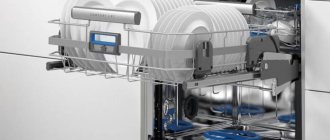An actively used dishwasher greatly simplifies the life of every housewife. When choosing this type of household appliance, many focus on appearance, but functionality is more important. To evaluate a model's usefulness, you need to know how long a dishwasher's wash cycle takes and decide whether they're right for you.
You will learn everything about the duration of standard and additional operating modes of dishwashers from our article. We will tell you how to choose equipment with the functionality that suits you personally. Thrifty housewives will find useful tips to reduce operating costs.
Dishwasher interior
At first glance, the operation of a dishwasher seems simple: install the unit, connect it, put detergents in the right places, arrange the utensils, select a program, start the equipment. Then you can forget about the dishes for a while and do something more enjoyable.
But I wonder what is happening inside the dishwasher at this time? After starting the machine, water flows into a special tray through an open valve. Enriched with detergents and regenerating salt, it heats up to the temperature you set.
The process itself is identical to washing dishes by hand. The structure and operating principle of dishwashing equipment are described in detail here. We recommend that you read this very useful information.
It depends on the program you have installed and consists of three to four stages:
- soaking if the dishes are very dirty;
- washing;
- rinsing;
- drying.
The duration of these periods is influenced by the initially set water heating temperature. The higher the threshold you set, the longer you will have to wait for the cycle to end.
The dishwasher unit consists of the following elements: control panel (1), sprayer blocks - upper and lower (2, 3), float valve (4), drain hose (5), power cable (6), supply hose (7), filter (8), intake valve (9), engine (10), pump (11), heating element (12), gasket (13), button (13), latch (14)
When soaking, which is sometimes called a pre-wash, the main dirt is washed off from the dishes with cold water without the use of chemicals from the main container. This function is convenient if dishes are loaded into the machine in stages as they accumulate. It will prevent dirt from sticking tightly to previously loaded kitchen items.
The washing itself involves treating the dishes with hot water at about 80ºC. You can simply increase the washing time, but the advantage of the first option is that no detergent components are used.
The diagram shows the process taking place inside the dishwasher. It is important to load high-quality washing products and select the correct mode before starting
Water along with the chemical composition is sprayed using special tubes located at the top or bottom of the body. The rocker washes dishes more efficiently. During rotation, it sprays water jets in all directions under powerful pressure.
At the end of the washing stage, the PMM automatically turns on the next one - rinsing and drying.
Experts do not consider pre-rinsing a mandatory procedure if the PMM is not started immediately. It is enough to simply remove residues from plates and pots so as not to clog the machine with them.
Rinsing in a dishwasher, similar to a washing machine, involves two stages. This is the only way to completely remove detergents from all surfaces of washed dishes.
Standard operating modes
Dishwasher programs are a sequence of operations that the microprocessor performs.
The main parameters are:
- Presence or absence of pre-soaking mode.
- Water heating temperature.
- Duration of the program.
After repeated use of the PMM, it will be easy to recognize how it functions and detect malfunctions by ear.
Types of drying in PMM
Drying completes the washing cycle. It comes in three types: blowing with heated air (turbo-drying), an intensive process with a heat exchanger, and condensation.
The first method involves blowing warm jets of air over the treated dishes. The implementation of the process is possible thanks to the presence of a fan built into the design. Drying occurs faster, but energy consumption is increased.
Enhanced drying is carried out due to the independent movement of air inside the housing as a result of the pressure difference. This method gives good results with more economical consumption of electricity.
The drying phase completes the operation of the machine. PMMs equipped with turbo drying are expensive, others are somewhat cheaper; when choosing, you should consider what is more important for you - a shorter drying stage or higher electricity bills
During condensation drying, drops of water evaporating from the surface of the dishes are transformed into condensation and settle on the walls, then flow down. This drying method takes a lot of time, but if there is nowhere to rush, then this method is the best.
Standard cycle time
Modes for different PMM models may differ. Still, there are four basic washing modes in a dishwasher, which each manufacturer includes in its program. These modes are called fast, normal, economical, intensive. Let's consider each of them as guidelines for choosing a dishwasher.
When choosing a quick wash, the pre-wash and dry function is no longer required. The process lasts about half an hour. In the instructions for some models, this type of dishwashing is called rinsing. This mode is used when a small amount of not very dirty dishes has accumulated.
In normal mode, which includes a fully completed cycle, the dishwasher runs for an average of two hours, of which:
- Rinse - from 5 to 10 minutes.
- Main wash – up to 50 minutes. at a water temperature of 65⁰.
- Rinse in three steps - up to 10 minutes.
- Drying - the rest of the time.
Economy mode significantly reduces time by increasing temperature and pressure. This results in less water being wasted, but energy consumption increases. The program contains a preliminary rinse, a wash at 50⁰, a double rinse, and drying.
Very dirty dishes are washed using an intensive mode for 2-3 hours. This program includes pre-rinsing, washing at 70⁰, rinsing in four steps, drying.
For efficient operation of the unit, it is necessary to place the very dirty surface of the dishes closer to the washer fluid sprayer. Knives in a dishwasher that is not equipped with a special container are placed with the blades down, and forks are placed with the teeth up
It is better to wash pans and pots in the “pre-soak” mode. Particularly greasy kitchen utensils should be kept in the sink under very hot running water before loading. This will help the dishwasher do a better job.
Some models are also equipped with the following programs:
- EatLoad-Run , which allows you to load dishes directly from the dining table. There is a quick wash at 65⁰, then rinsing and drying, and all this in 30 minutes.
- Wash delicate at 45⁰ . Used for crystal, porcelain, glass. Duration: 110 minutes.
- Car wash (Auto) - this program, without outside intervention, determines the degree of contamination and automatically sets the required amount of water, detergent and the duration of the process. The usual water temperature in this mode is from 45 to 65⁰, duration is 2 hours 40 minutes.
The latest PMM models have the Varlo Speed , which allows you to reduce time by up to 50%. Not everything is so simple here - while saving time, electricity consumption increases. When choosing a mode, you need to calculate what is more profitable for you - saving time or energy.
Floor-standing models that hold a minimum of eight sets have a half-load mode . This means that only one of the available two baskets is loaded. At the same time, the washing time is not reduced, but the volume of water, detergents, and electricity used decreases.
The variable washing program provides for simultaneous processes - washing dishes in intensive mode and soaking. These two jobs happen in different baskets. Using the program allows you to save about 25% of water while maintaining excellent washing quality.
To start the dishwasher, you need to correctly decipher the icons on the panel. Sometimes they are signed, but in the language of the country of origin
“Delay Start” function is very relevant . With its help, you can move the start by 1 – 24 hours. If you have a double tariff for electricity, this is very convenient.
Additional functions of PMM
In parallel with dishwasher modes, they can also have additional functions. Almost all of them are equipped with leakage protection. If there are small children in the house, you need a unit with the ability to lock the control panel or door.
The ability to add forgotten dishes after starting the machine is also a very convenient feature. Elite models are equipped with loading sensors. In this mode, the PMM selects both the volume of water and the time spent on the cycle.
Some models have additional elements - sensors for monitoring water purity and hardness. A sensor for monitoring the degree of water purity forces the unit to rinse everything loaded into the machine until the liquid becomes perfectly clean. If the water is very hard, the machine will determine how much softening salt to add.
The panel for launching additional functions for built-in PMM models is located at the end of the door
Built-in units in working condition project a red beam onto the floor plane. When the process is completed, it disappears or its color changes to green. This is very convenient, because... makes it possible to monitor the operation of the built-in dishwasher.
Control of washing modes
All modes in the PMM are coordinated in two ways: electromechanical and electronic. The second method is more comfortable, and all modern models are equipped with it. The first provides for the presence of buttons, switches and keys on the body, and they are controlled manually.
Control of some PMM models is simplified due to the presence of clear symbols in the designation of standard programs. These are glasses, pots and other items (+)
With electronic control, both the washing mode and other programs are set using commands. If the PMM board fails, only a specialist can repair it. Experience shows that most often the programmer will have to be changed.
The final stage of machine operation
At the end of the cycle, the contaminated liquid goes down the drain. This is followed by a drying stage. It can end in 30 minutes or last more than an hour.
A special signal sent by the device will notify you of the end of the program. The sound volume is adjusted using convenient indicators placed by the manufacturer on the control panel. With their help, you can completely disable the alert function if you plan to load the machine overnight.
When the unit stops completely, press the on/off button. Then the door is opened slightly to allow the dishes to cool faster.
After drying, a high temperature remains inside the unit, so it is not recommended to immediately empty it of its contents. In addition, cookware made from certain materials becomes very fragile when hot.
After the beep sounds indicating the end of the wash, you should wait a while before removing the dishes.
It happens that the cycle is completed, but the dishwasher does not turn off. The most likely cause is an electronic problem. This may also be a consequence of blockage of the drain hole with food debris. The machine cannot shut down correctly.
Program duration for some models
Let's see how the duration of the modes differs for individual PMM models. For this purpose, we will analyze several popular examples of dishwashers of different brands and the duration of washing with these machines.
In practice, different manufacturers set the cycle duration values to be identical. The exact time can be seen in the instructions or on the display (+)
Based on reviews from many users, we can conclude that the most frequently used modes are fast and intensive.
The final stage of machine operation
At the final stage of operation of the dishwasher, the used water is discharged into the sewer pipes. Then the stage of drying the dishes begins. Upon completion, the machine, as a rule, emits a signal and completes its work.
On the existing control panel there are indicators indicating the end of the program. After the machine has completely stopped, you need to turn it off. Experts recommend waiting about 15 minutes before starting to remove the dishes. This is because the dishes may still be hot after drying. Can open the door slightly to help the appliances cool down faster.
Water saving level in dishwashers
Both the selected washing mode and the PMM model determine how much water it will consume. On average, this is from 10 to 13 liters per procedure as a whole. Unlike manual washing, all water is used only for its intended purpose without any loss.
During the process, the working fluid is cleaned using special filters and is supplied completely renewed for rinsing. Economy modes reduce the amount of water consumed by 25%.
Water savings when using PMM are obvious. The unit uses a special technology in which the collected water is used several times
The profitability of PMM is indicated by symbols. Highly economical units are marked with the letters A, B, C. They consume 9 - 16 liters. Average-economical dishwashers are designated in the form of the letters D, E. They consume slightly more water - up to 20 liters. Low-efficiency machines with the letters F, G require 26 liters per cycle.
Detergents
Some dishwashers are equipped with a special compartment with a scale designed for pouring powder. This compartment allows you to dispense detergents. Please note that you cannot use laundry detergent or regular soap in dishwashers.
Detergents are available in three types, by adding to alkaline components:
- bleach;
- oxygen;
- enzymes.
Each product has its own characteristics. Powders containing chlorine are not intended for aluminum and silver cookware. Those containing oxygen are more widely used. Products with enzymes wash even at low temperatures, while being gentle on dishes.
We recommend: Installing an overhead sink: the main stages of installing a sink yourself
In addition, the products can be produced in liquid, powder or capsule form, but powder is the cheapest product. If the dishes are not too dirty, they can be cleaned in the dishwasher even without adding detergent, using only hot water. At the same time, the quality will be tolerable. For those who suffer from allergies and cannot easily tolerate detergents, they are replaced with baking soda, and vinegar is used instead of rinse aid. If you add a program with hot water to such components, the result will be positive. The required amount of such products is calculated independently, based on the water hardness in the region.
The positive characteristics of the dishwasher are the ability to wash with very hot water.
When choosing for a large family, you should consider its capacity. If the water from the tap flows quite hard, then there is a chance of getting limescale deposits on the washed dishes. To avoid this, you must use a special conditioner and softening salt.
How to load dishes correctly?
Sometimes improper loading of dishes causes the PMM to fail to complete the programs included in it and, as a result, deteriorate the quality of washing. All the details of loading dishes into the machine are listed in our recommended article.
If you place large kitchen utensils in the center - pots, pans, baking sheets, cutting boards, trays, the flow of water will be blocked. It’s better to move it all closer to the edges or lower it into the lower compartment.
The volume of a single load depends on the dimensions of the dishwasher. Some manufacturers, in the attached instructions, describe in detail the process of placing dishes in the PMM
If there is a large amount of dishes that need to be washed, you cannot process them all at once. Water and detergents will not have sufficient free contact with the surfaces of kitchen utensils.
To do this, there must be free spaces between kitchen utensils. If the dishwasher is overloaded, it will not be able to do its job efficiently.
For the dishwasher to function properly, it is important that the powder or detergent tablets are strictly in the compartment intended for this purpose. Due to the fact that the cycle is programmed in advance, all means come into effect precisely at the set time.
If there are streaks on the dishes, this indicates excess salt or rinse aid. When there is not enough detergent, dirty streaks will remain. If you detect food residues at the bottom of the unit and on the dishes, you should check the filters. Most likely they are clogged. Experts advise cleaning them after one or two washes.
Dishes that have not been washed for a long time or that have been burnt on must be pre-cleaned by hand. When excess foam forms during rinsing, it means that you have added too much rinse aid. In this case, correct setting of the dispenser or adding a defoamer in powder form will help.
Bosch dishwasher - operating instructions
The entire operation of the dishwasher is based on the action of an electronic board. The sensors built into it monitor the parameters of the level and temperature of water and air and monitor the degree of cleanliness of the dishes.
- The manual for the device is freely available on the Internet. It has been translated into Russian, there are illustrated examples and diagrams with tables. The user can read it using Adobe Acrobat.
- In addition to a step-by-step explanation of connection, the annotation contains descriptions of the programs, as well as:
- recommendations for first start-up, care, use of detergents, options for arranging dishes;
- a list of main parts with a brief overview of the operation, as well as safety precautions.
In addition, it lists possible malfunctions and how to eliminate them.
Before starting, the position of the unit is leveled using adjustable legs. The duration of the operating period directly depends on the accuracy of the installation of the machine.
Conclusions and useful video on the topic
Processes occurring in the machine during operation:
It is difficult to wash dishes by hand in very hot water. PMM does it better. The washing time depends directly on the selected mode and model of equipment. Dishwashing equipment is also supported by the fact that its use not only saves resources, but also the time spent on daily washing of kitchen utensils.
Would you like to share your own experience in operating a dishwasher and choosing the appropriate operating cycle? Is there information on the topic of the article that will be useful to site visitors? Please write comments in the block below, post photos and ask questions about things that interest you.
Is it harmful to the dishwasher if you run it frequently?
According to experts, the number of dishwasher cycles per week in the average household is about five. Do you want your car to serve you longer? Reduce this number if you can.
In a typical home, the dishwasher runs five times a week. Based on this average, those who use their appliance less than five times are likely to be less likely to repair and replace their dishwasher than those who use it six or more times.
A typical dishwasher has a lifespan of about 10 years, but if you run more than five cycles a week, you may need to replace yours after seven years or so. If you can reduce your cycles to fewer than five per week, your dishwasher could last 12 years or more.
So here's the bottom line: While running the dishwasher once a day, every day of the week may not be the best option for dishwasher longevity, it will likely save more water than if you wash dishes every day the traditional way. The question is which issue has higher priority, and that is up to you.
A couple of tips
The “half full” function of the equipment does not mean that in this case the use of water and electricity by this kitchen appliance will be at the optimal level. In most cases, the water consumption of a dishwasher is 60% of the usual amount. The situation is the same with electricity; in addition, overly dirty dishes may simply not be washed.
Systematic and intelligent stacking of dishes will allow you to fill the dishwasher as much as possible. This will make it possible not only to save water and electricity, but also to ensure perfectly clean dishes at the end. Usually, any product comes with instructions with detailed pictures and recommendations on how to lay out kitchen utensils.
It is necessary to take into account that a volumetric dishwasher is more profitable, based on the calculation of water consumption for one full load. But she will use water according to the program, regardless of the number of dirty dishes.
First wash
There is no need to rush to launch the PMM immediately after the test run. It will take time to cool down. How long and well it will last will depend on the correct use of the equipment.
Before you put the dishes into compartments, you need to inspect them. Remains of food are washed off under running water. If the machine has cooled down, load the dishes. Salt and rinse aid remain in the compartments after the first start, but you need to add detergent.
Proper loading is the key to clean dishes. There should be a distance between objects, then nothing will prevent the streams of water from rinsing the dishes.
Selection of household chemicals
PMM uses products in the form of powders, gels and tablets. Also, for the first start you need a special salt that softens the water. It prevents the formation of scale on machine elements.
The amount of salt that is poured into the compartment depends on the degree of water hardness. City services have the data, but there are modern models of dishwashers on sale that determine it themselves.
Loading the cart correctly
If the owner of the PMM does not have the opportunity to read the instructions compiled by the dishwasher manufacturer, then the following recommendations should be followed:
Frying pans, tureens, pots and any other large items are placed in the lower basket. If necessary, the stand located below can be removed. Glasses, dessert plates, forks, spoons and many other small items are placed on the upper shelves
It is important to maintain the distance between rows. Any dishes are placed upside down. There is no need to load easily breakable dishes and highly durable items into the machine at the same time. In case of urgent need for joint washing, you need to choose the temperature mode and program, taking into account the presence of fragile objects in the car.
Many dishwasher models have special compartments for small items. They are used to wash spoons and forks.
How to turn it on
The PMM is turned on as follows:
- loading cart;
- program selection;
- pressing the "Start" button.
You can start the dishwasher in 2-3 minutes. If after starting the program you need to put an object, the work is stopped by clicking “Stop process”. Such a button is available on PMMs produced by Bosch and other companies.
Finding a suitable program
You should pay close attention to the built-in functions of the appliance and study their purpose, and only then run the dishwasher for the first time. The programs are as follows:
- Soak. This function provides high-intensity washing of heavily soiled dishes. The process is divided into 2 stages: preliminary and main. The preliminary stage is soaking, the main stage is washing. Soaking is not a mandatory task of this mode; you can refuse it if desired. The soak function makes it easy to remove dried food residue.
- Standard mode. This program offers economical consumption of electrical energy and water when washing. This mode is intended for moderately soiled dishes without grease or dried-on food.
- Delicate wash. In order not to spoil the appearance of dishes made of crystal, porcelain, thin glass, earthenware, you should choose the delicate mode.
- Quick wash. This program is designed to wash dishes with water with the addition of detergent, then rinse with clean water.
For the first test run of the machine, you should select a mode with high washing intensity, and then select a mode according to the degree of soiling of the dishes.
Product benefits
Of course, for bachelors, buying miracle equipment may not be such a pressing issue, because there is a lot of advice on the Internet, including putting a disposable plastic bag on a plate. But for at least a small family, purchasing such a product is a real way out of the situation. In addition, a modern dishwasher can significantly save money on the use of water resources.
Consumption
What is the approximate consumption of a dishwasher? Of course, it will be slightly different depending on the brand, model and year of manufacture. But even outdated dishwashers are unlikely to consume more than 20 liters of water. Almost all manufacturers indicate in the technical characteristics of the product the main parameters of water consumption by washing equipment. It is divided, depending on the dimensions, into full-size and narrow. These purchase criteria show how many dishes a particular machine can hold, and how many items it can thoroughly wash in one wash.
13 – 14 regular sets of dishes can bring a full-sized product to shine. The maximum water consumption will not exceed 15 liters. Compact size machines (narrow) capable of processing from 6 to 9 sets. In this case, the equipment will take no more than 10 liters of water from the water supply system.
Saving
And yet, does a dishwasher save our water? According to experiments and consumer reviews, when washing dishes by hand in an amount corresponding to 1 dishwasher load, hot water consumption reaches about 70 liters, and cold water consumes about 30. It turns out that modern household washing equipment can significantly reduce the water supply meter readings.
So how much water exactly does a dishwasher use? Here's an example:
Bosch SPV63M50 (compact) - loading up to 9 sets, consumption 8 l;
Siemens SN66M094 (regular) - loading up to 14 sets, consumption 10 l;
Smeg BLV2VE (full size) - 13 rooms, 8.5 l.
For a small family and pensioners, a compact model is quite enough, otherwise you will have to spend excess water on washing just a few plates and you won’t be able to save money. Or, as an option, long-term accumulation of dishes to fully load the machine. The leaders in terms of savings at this stage are European brands. It is these machines that should be given preference if the factor of saving water resources is significant for the consumer
Well-known brands such as Electrolux, Bosch, Siemens pay special attention not only to saving tap water, but also electricity
The models presented in the example are premium products. The average power consumption ranges from 0.7 to 0.9 kW, depending on the size of the equipment. Many modern models have a half-load function; its use allows you to save up to 30% of water. The undoubted leader, according to consumer reviews, constantly tops the list of the best dishwashers, is Bosch.
Selecting work programs
The best washing effect is provided by the ECO (economical) program, but if the dishes are heavily soiled, you should still choose “intensive washing”.
For washing fragile dishes, a delicate mode is used, which differs from all others in that the water temperature will rise during the first rinse. By the way, this same mode is also suitable if the dishwasher contains dishes of completely different types and materials.
Important! It is impossible to tear off the machine immediately after the last cycle is completed. It is recommended to wait about 25 minutes more to allow the dishes to cool down.
Finally, it should be noted that you need to wash the machine, or rather its filters, after each start; to do this, it will be enough to wipe them with a damp sponge
We should not forget about the sprinkler nozzles; it is very important to ensure that they are not clogged
Description of controls
In everyday use, a Bosch dishwasher is unlikely to cause much difficulty in use. Many lights and modes remain unused. But to use a Bosch dishwasher comfortably, you need to know what each of the signal indicators means. Let us first consider those that are present on almost all models and indicate various stages of work.
- “End” indicator – indicates the end of the dishwashing cycle.
- The Brush light comes on while the dishwasher is starting.
- The “Tap” indicator signals the period of operation when the cavity of the machine is filled with hot water.
- The “Salt” indicator (two arrows in the shape of the English letter S) - indicates the presence of a salt absorbent, which helps clean the heating element from scale that has formed on it.
- The “Rinse aid” indicator (snowflake, sun, star) indicates the presence of dishwashing liquid in a special compartment.
We suggest you read How to get rid of rats in an apartment on the first and second floor
The keys responsible for setting and regulating the upcoming wash are allocated to a separate category. The functionality of each Bosch model is very different, so only those buttons that are most common will be described.
- “Pan” this symbol indicates an intensive mode of washing dishes at a temperature of more than 70 degrees Celsius and lasting about an hour. Used for the heaviest stains.
- "Cup and saucers" (or Auto mode) is the standard operating mode. Similar to when we wash dishes by hand. Water temperature - 50 degrees. Duration – up to two hours.
- “Cup and plates” (ECO, economy) – mode of reduced water consumption. It differs from the standard one in the presence of a rinsing stage.
- “Glass (cup) with two arrows” accelerated washing. It passes in half an hour at a temperature of about 40 degrees Celsius.
- “Glass” delicate mode. Used for fragile dishes.
- “Baby food bottle” – treating dishes with hot water, which destroys germs. Used to disinfect baby supplies (dishes, pacifiers, etc.).











